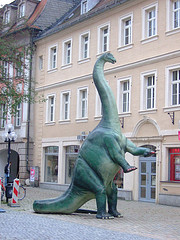

Location: Kanzleistr 1
Tel. +49 0921/ 51 1211
Open: 10am- 5pm Tue- Sun
10am- 5pm July August daily
Museum of Natural History is a small museum devoted to the history of biological diversity, geology and mineralogy of the region that is known as an Upper Franconia. It covers roughly last 500 million of years. The region switched several ecosystems in its long history. At some point it was a shallow tropical sea, tropical forest, cold tundra and finally lush mixed forests. It is one of the museum that might be interesting for children as well as adults. It offers many activities and can keep them occupied. Don't miss a scale model of a large dinosaur.
In 1832, District President Ferdinand von
Andrian-Werburg called for the establishment of a natural history
cabinet. Count Georg zu Münster was one of the first to respond to
this call by making 14,000 exhibits available as the basis for the
new collection. As early as 1833, the district natural resources
cabinet was opened in the Bayreuth Chamber Presidium. The collection
initially contained 19,209 fossils and over 3,000 minerals and
rocks.
In 1841 the collection moved to the first floor of the
New Castle. It lived essentially from the voluntary work of
individual people: Government secretary Metzer took over the
conservation of the collection items, followed by the clerk Rath,
both in their free time. In 1849 the collection had to be moved to
the district agricultural and trade school. Karl Friedrich Wilhelm
Braun, who was involved in the construction from the start and
published the first catalogue, became curator in 1850. He retained
this office until his death in 1854.
After Kustos Braun died
in 1854, the Kreis-Naturalien-Cabinet only served as a school
collection, which was managed by various natural history teachers.
Only in 1872 with the purchase of the mineral collection of the
notary Käfferlein did the collection emerge from its shadowy
existence. It was not until 1914 that the collection was made
accessible to the public again and appeared as a scientific
institution. Theodor Schneid was in charge of the collection, which
had now found its home in the former municipal branch bank building
on Friedrichstrasse. Even after Theodor Schneid was called to
Bamberg, he continued to look after the Bayreuth collection from
there.
After the First World War, the exhibits returned to
the ground floor of the New Palace in 1924. In addition, Schneid
wrote the first museum guide, which was also published in 1924. In
1934, the city of Bayreuth acquired the Frosch collection, which it
added to the district natural objects collection as a loan.
After the Second World War, Anton Kolb from Bamberg took over the
management in 1955 and enabled the museum to reopen in 1958. In 1964
the district natural objects collection was renamed the Upper
Franconian Museum of Earth History in Bayreuth.
In 1981 the
government announced the exhibition rooms in the New Palace, so the
museum had to be closed. The Natural Science Society of Bayreuth,
the University of Bayreuth and numerous regional collectors of
fossils and minerals campaigned massively for the reopening of the
collection, which was stored in sealed boxes at the University of
Bayreuth and was therefore not accessible to anyone. The General
Directorate of the Bavarian State Natural Science Collections
accepted the demand for the reopening of the Oberfranken Geological
Museum and found additional support from the regional council of
Upper Franconia and the city of Bayreuth.
In 1997, the
sponsorship agreement was concluded: the city of Bayreuth took over
the sponsorship of the museum from the district of Upper Franconia,
and the general directorate of the Bavarian State Natural Science
Collections took over the scientific supervision. The name has now
been given the new name Urwelt-Museum - Oberfränkisches
Erdhistorisches Museum Bayreuth. In 1998 the museum was opened in
Lüchau-Haus (Kanzleistraße 1), which is owned by the city of
Bayreuth.
The Urwelt-Museum shows exhibits of
the history of animate (paleontology) and inanimate (geology and
mineralogy) nature in Upper Franconia on approx. 600 m². Exhibits
include shell calcareous dinosaurs, a world-rare Capitosaurus
arenaceus skull and other fossils, rare minerals, and a walk-in
model of a gold crystal.
A skull and numerous vertebrae of
the fish dinosaur Temnodontosaurus from the former Mistelgau clay
pit have also been on display since 2007. The skull is over a meter
long.
The permanent exhibition Urweltmeer Mistelgau has been
on the first floor since 2012. There, a tropical flat sea, which
covered the region 180 million years ago, is represented by fossils.
In the outdoor area behind the museum, models of dinosaurs that
are several to ten meters high are on display. Other models are in
the pedestrian zone, not far from the entrance to the museum.
In 2016, what is believed to be the oldest skeleton of an
allosaurus juvenile was exhibited in the museum.